This is a guest post from Grace Austin of Extreme Nomads.
Coming from somebody who’d never so much as moved their goldfish from room to room, the notion of flying our newly adopted Thai soi dog from our home in Pranburi all the way over to Europe was daunting, to say the very least.
Nevertheless, we did it! And without any major F-ups (yay for us!) and Blacky Bandana successfully spent the past month travelling through France and onwards to her new home in Ireland.
In this article, I’ll walk you through the entire process of travelling with a dog from Thailand to Europe including all the things you’ll need to prepare (and exactly how to prepare them).
Let’s start with the basic requirements…
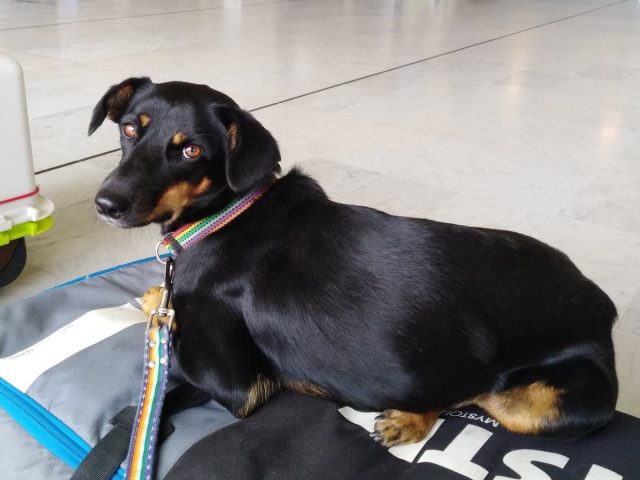
Requirements for Travelling with a Dog from Thailand to Europe
You’ll need to prepare the following things for your dog in this order:
- Microchip
- Rabies vaccine (presented in a pet passport or rabies certificate)
- Titre serology report
- Export license/health certificate
Prep Time Needed
A total of four months is needed from the date of microchipping and initial vaccination to the date that the dog will be cleared for travel. Here’s how it works.

EU requirements state you must microchip your dog prior to getting their rabies vaccine (if your dog already has a rabies vaccine, you’ll want to keep reading to see how that affects the process). Following that, vets recommend that you wait one month for the vaccine to propagate and for your dog’s titre levels to rise sufficiently.
After the month is up, you’ll need to return to the vet for a blood test. A blood sample will be taken and turned into an spoil-proof serum, which will then be sent to an EU approved testing center for the rabies titre test. You dog will be able to travel to Europe three months from the date of blood sampling at your vet.
What If My Dog Already Has a Valid Rabies Vaccine?
If your dog has a valid rabies vaccine (administered in the past year) then they won’t necessarily need to get another one right now. In our case, we were under time constraints (with just a three month visa, we couldn’t wait four months for our dog to be ready for travel) and since she already had a valid rabies vaccine from seven months ago, we took a slightly-not-by-the-book chance.
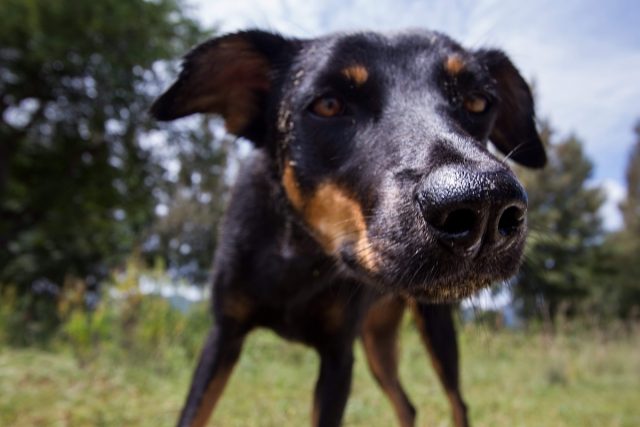
Our vet, who we knew well and was super accommodating, agreed to backdate the microchip to before the rabies vaccine was administered. Once again, microchip first and rabies vaccine second is a requirement under EU law.
When we did this, our vet advised us that we were taking a risk that our dog’s titre levels wouldn’t be high enough to pass the test, so if you decide to go this route it’s important that you consult with your vet, get their professional advice, and understand the level of risk involved.
In our case, Blacky’s seven month old rabies vaccine proved enough for her titre levels to be three times the minimum requirement for her to pass the titre test. Woohoo!
Getting the Microchip
Many local vets will have the facilities to microchip your dog; just call and check if they have the equipment needed. We got ours done at Pet Time in Hua Hin for 900 baht (about $30 USD) – a fantastic place with staff that are totally on the ball.
Getting the Rabies Vaccine
If it’s the first time your dog has been inoculated against rabies, you’ll need to get two jabs about one month apart (you can squeeze this down to a fortnight if you’re stuck for time, but two weeks apart is the minimum requirement). This constitutes the initial vaccine and one booster. Each rabies vaccine cost 70 baht at our local vet (about $2.20 USD). [Shandos – Double check whether this is required in the country where you are located – in parts of the world this is not required.]
It’s then recommended that you wait 30 days before taking your dog in to have its blood tested, to allow for sufficient time for the vaccine to spread effectively throughout the body and produce the amount of titre needed to pass the test.
This stage can also be squeezed down to a fortnight if you’re in a hurry, but no less than 14 days – and most vets will tell you that waiting less than 30 days carries a risk of your dog failing the titre test.
Blood Sampling and Titre Test
The European regulations are super strict, and require your dog’s blood to be tested by a European approved lab (which, naturally, only exist in Europe). [Shandos – There’s also some approved labs outside of Europe, including one in Australia, here’s the full list.]

So this means you need to get blood drawn in Thailand, have it made into a serum (which stops it from spoiling in transit), and send it off to Europe. Our dog’s blood was sent to a lab in Edinburgh.
Because of the rigmarole involved in this step, it’s the most costly part of the process. (Apart from the flight itself, which can be more or less expensive depending on which airline you fly with. We’ll get to those details below.)
To make everything easier for ourselves, we did this stage through a professional pet relocation service based in Bangkok called Relo4Paws (highly recommended! James, the man behind it, is an awesome chap from the UK who seriously knows his stuff). The cost was 8,000 baht (about $250 USD).
Doing it on your own is cheaper, but we really wanted the reliability of the company – since we had no clue how to do it on our own. [Shandos – Getting this done in Australia without the complications of sending it across the globe still cost us about the same.]
Results of the titre test take a few weeks to come back. When they do, you’ll receive a certificate which states everything from the name of the lab, the person who tested the sample, and the levels of titre recorded in the blood.
It will also state your dog’s microchip number, which is absolutely essential as customs officials in Europe will check this to make sure it corresponds with the microchip certificate and reading (when scanned) of the chip implanted in your dog.
Flying Your Pet from Thailand to Europe
Picking an Airline and Flying Method
You have two options for flying your pet from Thailand to Europe: either as cargo or oversized baggage. There’s no better or worse option here, but there are some factors about each which will surely help you decide which is the right choice for you and your dog.
Let’s start with cargo flights. While they are the more expensive option (we were quoted a whopping 35,000 baht (over $1,000 USD) to fly our 12kg dog from Bangkok to Dublin) cargo flights are often more direct.
If you’re looking to take your dog from Thailand to the UK or Ireland, note that it’s currently impossible to fly them in directly as oversized baggage – so many passengers choose to fly them as cargo. When flying as cargo, your dog will may be unaccompanied by a human; you’ll take your normal passenger flight and meet them on the other side.
As for oversized baggage: this is generally the cheaper option, although rates differ between airlines. As of 2022, Air France charges €400 for pets to fly in the hold, while KLM also charges up to €400.
We got great deals for our tickets with Thai Airways, though they are a bit more on the expensive side for animals. We paid $450 USD for Blacky (which was their rate for dogs between 10-20kg in 2019). When you find the flight you want to take, call the airline and check if there’s availability for pets onboard, plus that the plane is suitable for pets. You can then book your dog’s spot over the phone.
Now, our final destination was Ireland, but being unable to fly her in directly, we chose a flight that landed in Paris and from there we planned to spend some time in France and make our way to Ireland on the ferry. This is the most common way of getting dogs from Thailand to the UK or Ireland (apart from cargo flights, that is).
Travel Box for Your Dog
You’ll need to get an airline approved box with a lockable metal grate in the front and air vents along the sides. This can be purchased from any good pet store in Thailand. The box will need to be big enough for your dog to comfortably stand, sit, and lie down without being cramped.
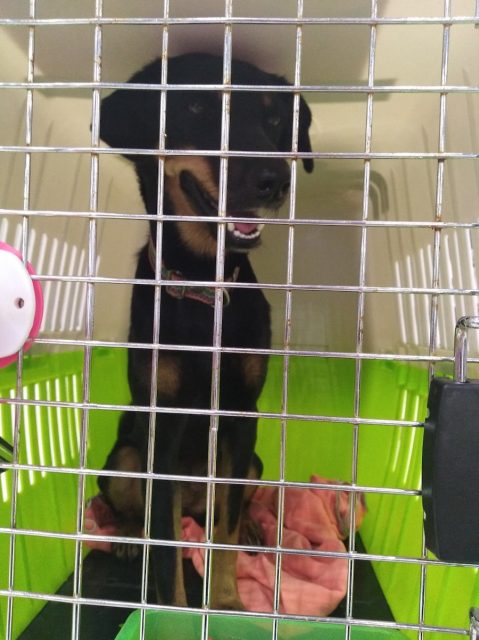
Getting the Health Cert and Export License
This requires going to animal control in Suvarnabhumi a few days before your flight. Your dog will be checked by the official vet, who will then fill out the necessary forms stating that your animal is disease free and fit to fly.
Again, we did this with the support of Relo4Paws who picked us up from our hotel in their dedicated pet transport van, brought us to animal control, and went through the whole process with us. It was fantastic to have them there; they knew all the vets and staff working in there and everything went totally smoothly.
The health check took less than five minutes and Relo4Paws picked up the paperwork from them later that afternoon. If you do it on your own, you’ll need to go back in the afternoon yourself and collect it. The export license is valid for 10 days upon issue.
The Airport and Flight to Europe
You’ll want to get to the airport with plenty of extra time. Take your dog and their travel box to the normal check-in counter and present their passport, titre serology report, microchip certificate, and export license/health certificate.
The staff at the check-in desk will make sure everything’s in order, you’ll be shown to a counter to pay the transport fee, and then you bring the dog inside the crate to the oversized baggage area, where they’ll be scanned and swept off to the pet section of the airplane. Next time you see them will be at the airport on the other side!
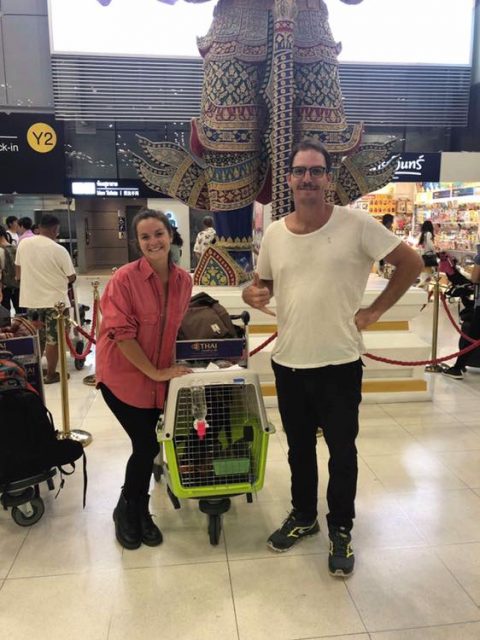
Once again, Relo4Paws came with us and helped us through this entire stage while we were able to spend some final moments with Blacky and making sure she was nice and calm as she settled into her travel box. I can’t rave enough about how worth it it was to pay for that extra service!
Landing, Pickup & Customs in Paris
If you’ve flown your dog as oversized baggage, you’ll collect your dog from the same place where you pick up your luggage. No – they won’t be spinning around on the revolving luggage belt (we hope!) but placed down next to it waiting for you.
When you pass through customs, you’ll need to declare that you’re travelling with your dog. You may be asked to present your papers depending on the country/officer on duty. We were not asked to show papers at Charles de Gaulle in Paris, and even when we asked them if they needed to see and/or stamp the papers they said no.
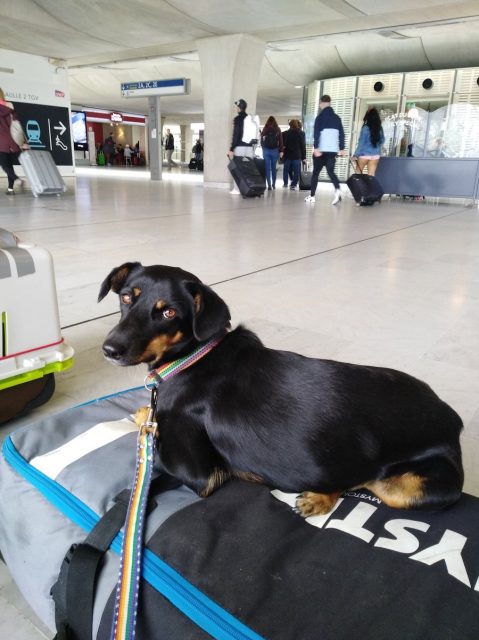
We later found out that they absolutely should have stamped them – as we ran into some difficulty a few weeks later when leaving France via ferry to Ireland and didn’t have a stamped form. Thankfully, the border control officers there were familiar with this issue and we were able to continue our travels.
But be warned, you most likely will need to have your papers stamped when entering the country if you plan on doing onward travel, so make sure to double and triple check at customs upon arrival.
Wrapping It Up
Travelling with a dog from Thailand to Europe can seem like a stressful affair, but once you break down the steps and tackle them one by one, it’s not so bad. Just remember to get (in order):
- A microchip
- Rabies vaccine and pet passport or certificate
- Titre test
- Health certificate and export license
And if you’re still feeling lost, there’s a phenomenal support team available for hire at Relo4Paws who will take the entire process off your hands.
Good luck, and happy doggy travels!
About the Author
Grace is an outdoor adventure addict, fluffy woofer lover, and blogger at Extreme Nomads. Having spent two years living in Thailand and subsequently moving her rescue doggo over to her home base in Ireland, her future travel plans are set to include her pup from now on.
You May Also Like
- Taking Your Dog to Europe: Vaccines & Paperwork
- How to Travel with a Dog to the UK from Outside Europe
- Which Major Asian Airlines Allow Dogs in the Cabin?
- Are Dogs Allowed on Trains in Asia?
Inspired? Pin this to your Pinterest board!


Hello, my sister lives in Pattaya and will be flying back home to Brussels in June. She has a PUG dog and is worried about transporting him over as she has heard that some snub-nosed dogs are not allowed to fly on certain airlines. Do you have any information on this, or will the healthcheck clear him to fly?
Many thanks,
Alexandra Bennett
Alexandra – This depends on the airline. Some airlines don’t fly snub-nosed dogs, while others will accept them, but often require a larger than normal crate plus an extra waiver to be signed due to the increased risk. Also, this only applies to the dogs flying in the hold – usually in the cabin there are no issues, but I’m not sure how large the pug is – usually there is an 8kg weight limit in the cabin, including the carrier. In any case, I would urge your sister to speak to her vet about the health of her pug. In snub-nosed dogs the degree of breathing issues varies greatly. The vet should be able to advise whether the pug is up to the long flight. If her pug has breathing issues, the risk might be too great.
This article perfect as we’re currently working through the stages to bring our dog (and cats) back with us.
Can I ask how you found bringing your dog from France to Ireland? You touched on a complication at the port but where there any issues of note getting them on the boat, when you got back to Ireland, etc? Also do you need to provide an address or is everything fine once you’re on the boat?
Thanks for any advice you can provide and your awesome blog post!
Johnny – Sorry, but this was a guest post, so I don’t have personal experience on this route. But based on other ferries that I’ve taken myself with my dog between EU countries, we haven’t had to provide an address. Plus the checks for pet paperwork usually occur when you’re checking in for the ferry (if at all), not when you arrive at the other end.
I am about to fly with my dog from Thailand to the UK. I will first fly to Amsterdam and then take the ferry. I have a question about the dates of vaccines etc. If I fly to Amsterdam first is it still a 30 day wait or 21 days, as Europe says 21 days before flying and UK say 30 days before flying.
Second question, when you flew with your dogs, did you need to show all documents, vaccination book, microchip cert etc. I am a little worried, my dog had a rabies vaccine (before microchip) and a booster (after microchip) but the vet took blood sample before the booster and said that it was OK because my dog already had a rabies from previous year (but, will they accept this as before microchip) the booster rabies vaccine is after the microchip, but this means the dates before travel will not be 30 days.
Sorry, I’m not sure if I understand your timeline. With the dates of rabies vaccines for both Netherlands and UK, you will need to wait 21 days after the vaccine before entering either country. However, for coming from Thailand, you will need to wait 3 months after the date of the rabies titre test. The main paperwork that will be looked at are the health certificates, but other related paperwork may be looked at. The UK in particular is quite strict with checking everything.